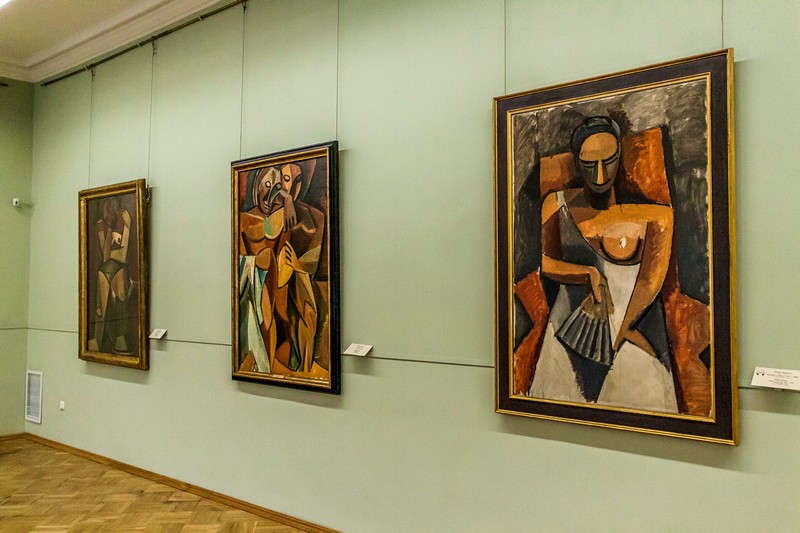Modern European Art
The Hermitage's collection of impressionist and post-impressionist art is among the most famous in the world, and one of the key reasons to visit this extraordinary museum. The decision, effected in 2014, to move the collection from the upper floors of the main Hermitage complex across Palace Square to the General Staff Building now gives this superb collection a dedicated, modern exhibition space where masterpieces of fin de siècle art can be displayed to their full advantage.

The Hermitage's collection of Modern European Art, the bulk of which is made up of French impressionist and post-impressionist painting, is divided between those works that were received into the Hermitage collections after the Revolution, and art seized from Germany after World War II. Displayed to the world for the first time in a 1995 exhibition entitled "HiddenTreasures: Impressionist masterpieces and other important French paintings preserved by the State Hermitage Museum", the collection covers nearly all of the major painters working in France in the final decades of the 19th century and first twenty years of the last century.
Claude Monet (1840-1926), a leading Impressionist painter is exhibited in Room 403. The earliest painting by Monet exhibited is Woman in the Garden (1867) predating the First Impressionist exhibition in Paris by 7 years. The light in the painting gives texture to the viewer's experience.
Also exhibited are works from 1870 to 1880 which show the growth and refinement of his style. The latest dated picture, Waterloo Bridge - Effect of Fog (1903) is one of a series of famous views of London. The view in the painting was inspired by the view from Monet's balcony at London's Savoy Hotel while the painting itself was completed in his studio in Giverny. This represents a break from his earlier theory of plein-air, which he considered unsatisfactory when painting fog scenes.
Also exhibited in the Claude Monet Room are: Eugène-Louis Boudin (1824-1898) - called "the king of the skies" by Jean-Baptiste-Camille Corot - who was an influence on the 18 year old Monet, Armand Guillaumin (1841-1927) - noted for his intense use of colour, and Albert Lebourg (1849-1928) - exhibitor at the acclaimed Les XX exhibition of 1887 and the Fourth and Fifth Impressionist Exhibitions.

Pierre-Auguste Renoir (1841-1919) is exhibited in Room 407. Impressionist works here are focused on portraiture. Man on a Stair and Woman on a Stair (circa 1876) are large panel paintings of the Charpentiers, Parisian publishers of the period. They are typical of the Impressionist style in their depiction of contrasting light and unusual visual perspectives. Also exhibited are the representative Portrait of the Actress Jeanne Samary (1878), Lady in Black (1876), Young Woman with a Fan (1881) and Child with a Whip (portrait of Etienne Goujon 1885). This work is somewhat unusual in that the face of the child is rendered in a classically precise line while the rest of the work is highly impressionistic.
The master Post-impressionist painter Vincent van Gogh's works are to be found in Room 413. On display are contrasting works showing his growth as an artist from the Impressionist influence to his own later Post-impressionism. Earlier works are from Van Gogh's time in Arles, Provence during 1888, while the later ones were painted in Auvers-sur-Oise, north-west of Paris. The picture titled Lilacs (1889) was painted in the grounds of Saint-Paul asylum in Saint-Rémy-de-Provence while Van Gogh was a patient. Other works include: Portrait of Madame Trabuc (1889), Morning: Going Out After Millet (1890) and White House (1890); which was completed just 6 weeks before the artist's death in 1890.
Room 416 shows works by Pierre Bonnard (1867-1947) a founding member of the Nabis group ("prophets" in Hebrew). His triptych titled On the Mediterranean is hung to centre the space. The work was commissioned by Ivan Morozov, a major Russian collector of avant-garde French art. Bonnard's Morning in Paris (1911) is an example of the influence of cityscapes in Post-impressionism, typical of modernist ideas of the time. A theme echoed in the companion piece Evening in Paris of the same year.

Ker-Xavier Roussel (1867-1944), another Nabis artist, has examples of his mythology influenced works also hung in the room.
Works by Henri Matisse (1869-1954) are exhibited in Room 440. Early large scale paintings, such as the pair of panels known as Dance - showing Matisse's early fascination with primitive art - and Music - painted without preparatory sketches (1909). Family Portrait (1911), Conversation (1909 to 1912) and Fruits, Flowers, and the Panel "Dance" (1909) - an early version of Dance is curiously included in the painting. Matisse's time in Morocco brought about Vase of Irises, Bouquet (Arum Lilies), Moroccan Amido, Zorah Standing, Standing Maroccan in Green (Standing Riffian) (all from 1912), and the most famous work from this series entitled Arab Café (1913); a wonderfully meditative piece. The collection also contains: Woman in Green (circa 1909), Girl with Tulips (1910), Portrait of the Artist's Wife (1913). Later works in the collection are: Balerina (circa 1927), Young Woman in a Blue Blouze (Portrait of Lydia Delectorskaya) (1939), and Portrait of Lydia Delectorskaya (1947), the subject was employed as Matisse's wife's companion and as his assistant. She later wrote a book, With Apparent Ease With - Henri Matisse: paintings from 1935-1939, about Mattise's technique.
Also exhibited in the fourth floor are collections by such major artists as Cézanne, Degas, Gaugin, Picasso and Pissarro. The Picasso collection covers his most popular early periods, and includes Sisters, from the painter's Blue Period, and several cubist masterpieces including Three Women (1908) and a stunning Still Life of 1913.

